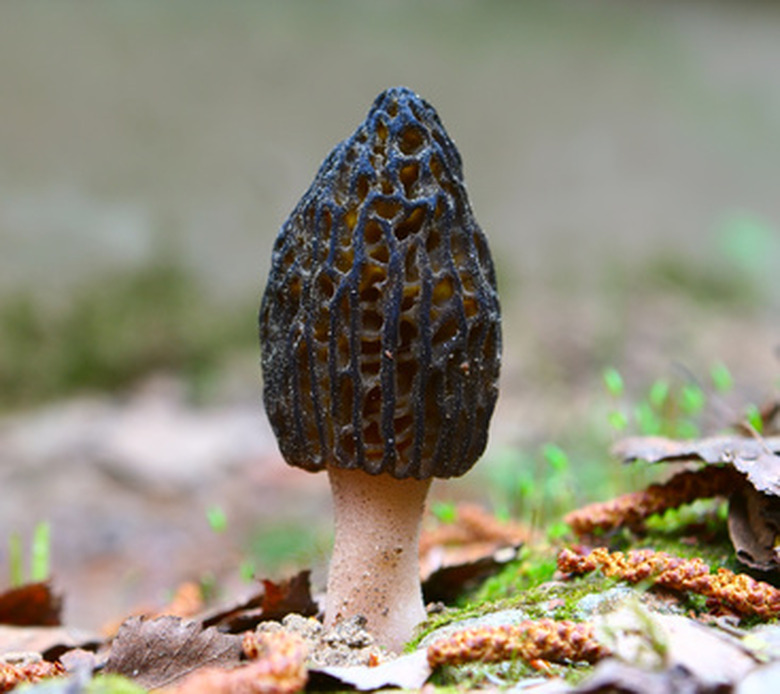Hunting For Morel Mushrooms In Pennsylvania
Spring is the time for morel mushroom hunting in Pennsylvania and throughout North America. These tasty fungi – with a flavor described as nutty or meaty – are often an elusive quarry. Knowing the conditions that favor morels and where they typically grow helps hunters narrow the search.
Watch the Weather
Watch the Weather
Morels typically emerge in Pennsylvania during the four-week span between mid-April and mid-May. Local weather conditions more precisely dictate start and end times as well as the length of the season each year. Some morel hunters watch for dogwood, lilac or wildflower blooms, as these events are triggered by the same weather that prompts the emergence of morels. Warmth is crucial to morels. When spring days reach around 60 degrees Fahrenheit while the nights remain in the 40s, and when the ground warms to about 50 degrees, start looking. Begin your hunt on south-facing hillsides. They receive the most sun, therefore more warmth, in the early part of the season. Try north-facing slopes in May.
Finding Morels
Finding Morels
Mushrooms are fruiting bodies of an underground rootlike system called mycelium. Mushrooms often grow in relationship with trees, especially dead or dying trees. Morels often emerge near certain tree species, such as:
- elm
- tulip poplar
- ash
- sycamore
- apple
Soil is also an important consideration. Loamy soil with its mixture of sand, clay and decaying organic matter provides nutrients sought by morels. Creek banks often boast this soil type, so they are excellent areas to hunt. These mushrooms seem to pop up after land is scoured by man, machinery or natural events. Logged areas, land disturbed by floods, burn sites and old orchards are good hunting grounds for morel mushrooms.
Where to Look and Where to Avoid
Where to Look and Where to Avoid
Pennsylvania allows the harvest of morels for personal consumption on lands managed by the Pennsylvania Game Commission and in Pennsylvania State Parks. The United States Forest Service also allows the collection of morels on public land it manages provided the collection is for personal use. Commercial harvesting is typically prohibited or heavily regulated. City and county parks often discourage harvesting morels except with written permission. Always check with private landowners before hunting on their land.
Identifying and Collecting
Identifying and Collecting
A conical, sponge-like appearance make morels one the of easiest mushrooms to identify, but two similar species – the false morel and the half-free morel – can cause gastrointestinal discomfort or worse if eaten. Always positively identify any wild edible before picking or consuming. Local mycological societies and clubs are excellent sources of information and assistance. After positively identifying a morel, cut it off close to the ground using a knife. Once you find a morel or two, take some time to search the area more thoroughly. Morels often grow in bunches. While hunting, keep your harvested mushrooms in a mesh sack. Each morel has between 250,000 and 500,000 microscopic spores. The mesh allows those spores a chance to release, increasing your odds of finding morels in the same territory in subsequent years.
A Word of Caution
A Word of Caution
Early spring is an excellent time to be in the woods. However, it's also the time when snakes emerge from their winter dens, ticks scatter, poison ivy grows and bears forage after hibernation. Those are not reasons to avoid morel hunting but to take sensible precautions. Long pants and long-sleeved shirts help protect the skin. A little bug spray wards off those biting insects, and boots protect feet and ankles. If hunting in bear territory, make a little noise. Watch where you place your hands before reaching. Snakes tend to curl among the leaf litter.
Cite This Article
MLA
Korpella, Robert. "Hunting For Morel Mushrooms In Pennsylvania" sciencing.com, https://www.sciencing.com/hunting-morel-mushrooms-pennsylvania-6740319/. 22 November 2019.
APA
Korpella, Robert. (2019, November 22). Hunting For Morel Mushrooms In Pennsylvania. sciencing.com. Retrieved from https://www.sciencing.com/hunting-morel-mushrooms-pennsylvania-6740319/
Chicago
Korpella, Robert. Hunting For Morel Mushrooms In Pennsylvania last modified March 24, 2022. https://www.sciencing.com/hunting-morel-mushrooms-pennsylvania-6740319/
